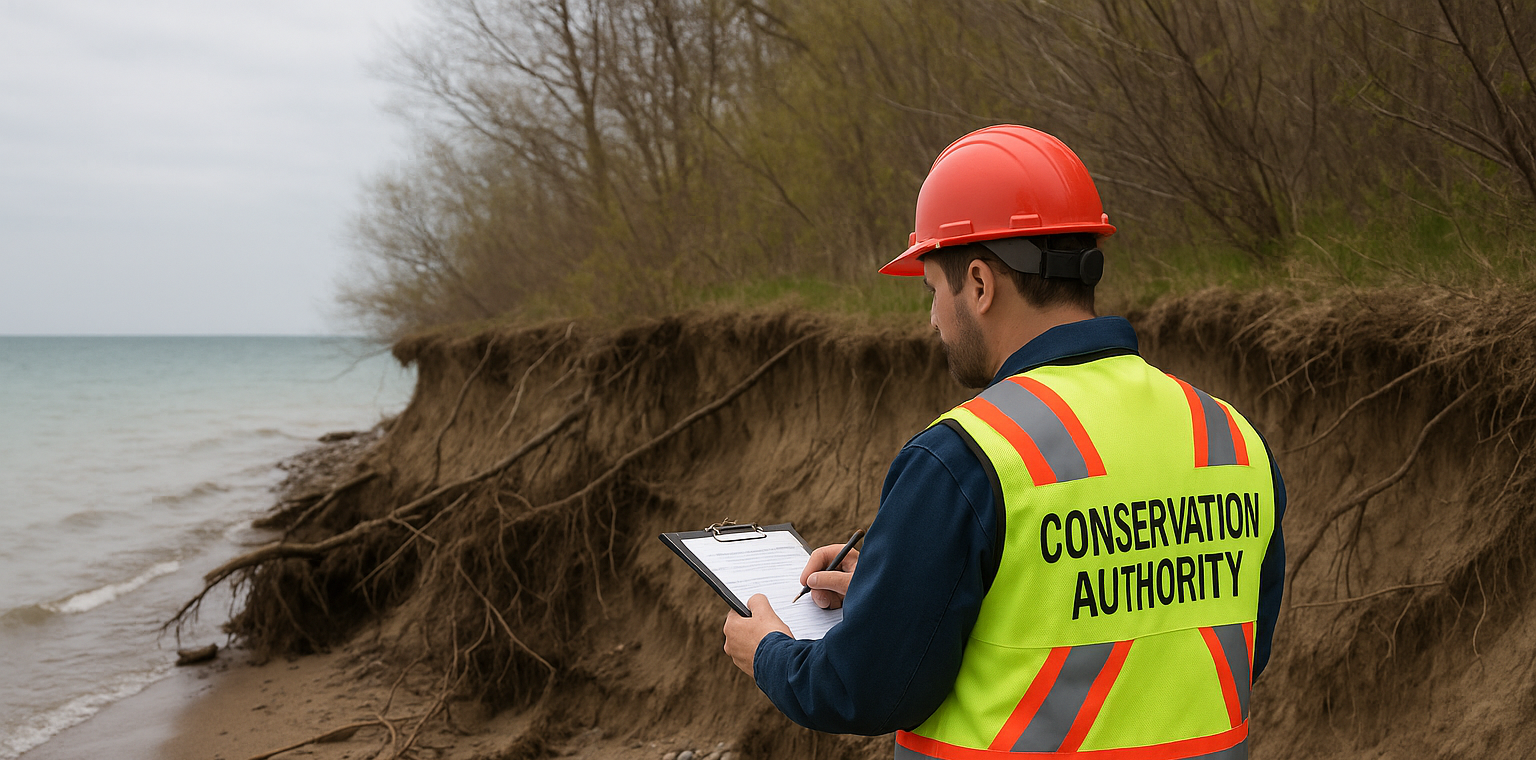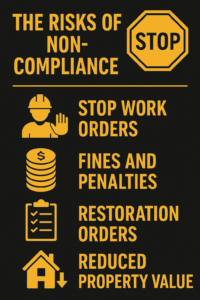Waterfront properties in Eastern Ontario are some of the most desirable pieces of land you can own. Whether it is a cottage on the Rideau Lakes, a family home in Frontenac, or a property along the Napanee River, living near the water brings unique beauty – but also unique responsibilities. Any waterfront excavation project in these areas must be carefully planned to comply with conservation authority regulations.
One of the most important rules is the setback. A setback is the minimum distance you must leave between excavation activity and the water’s edge. Conservation authorities use setbacks to protect shorelines, control flooding, and preserve habitats. For property owners, setbacks can determine how you design and plan your project.
At M. Riddle Excavating, we help property owners navigate conservation authority rules to complete excavation projects that balance functionality with compliance.
What are Conservation Authority Setbacks?
Conservation authorities establish setbacks to protect shorelines, rivers, wetlands, and floodplains. These distances vary depending on erosion risk, flood mapping, and ecological sensitivity.
For example:
- The Rideau Valley Conservation Authority (RVCA) regulates work within 15 metres of a floodplain or wetland boundary under Section 28 of the Conservation Authorities Act.
- The Cataraqui Region Conservation Authority (CRCA) requires permits for work within 30 metres of watercourses and wetlands.
- The Quinte Conservation Authority outlines similar restrictions for shoreline alteration and grading.
These rules ensure property owners do not destabilize banks, harm aquatic habitats, or build in areas vulnerable to flooding.
Why Setbacks Matter in Waterfront Excavation
When planning excavation work near a shoreline, setbacks directly affect the scope and feasibility of a project. They exist for several critical reasons:
- Erosion control – Excavating too close to the water accelerates shoreline erosion, which can damage both the environment and the property itself.
- Water quality protection – Natural buffer zones filter stormwater runoff, keeping sediments, fertilizers, and contaminants out of the water.
- Flood protection – Setbacks prevent structures from being placed in flood-prone areas where seasonal water levels could cause damage.
- Habitat preservation – Shoreline vegetation and shallow water zones are vital habitats for fish, amphibians, and birds.
Ignoring these rules can lead to costly fines, project delays, and even legal orders to restore the site to its original condition.
The Permitting Process
Before you begin a waterfront excavation project in Kingston, Napanee, Frontenac, or Rideau Lakes, you must apply for a permit with the local conservation authority. The process usually starts with an initial consultation. During this step, authority staff confirm whether your land falls within a regulated area. Next, you must prepare and submit a site plan that shows where excavation will take place, how close it is to the shoreline, and where structures will sit. Authorities also require an erosion and sediment control plan that explains how you will manage soil and runoff during construction. Finally, the authority reviews your application and decides whether the project meets environmental and safety standards.
The approval process can take time, especially during busy building seasons, so planning ahead helps prevent delays.
Setbacks and Common Waterfront Projects
Setbacks affect almost every type of waterfront excavation. If you plan to build a new foundation or basement, you must site it outside regulated zones. Septic systems require additional setbacks to protect water quality. Driveway excavation and grading must avoid buffer areas to prevent erosion. Even retaining walls and shoreline stabilization projects require permits so conservation authorities can confirm they will not make erosion worse downstream.
Landscaping projects such as creating a beach or reshaping the shoreline also require permits. Authorities regulate this type of work closely to protect fish habitats and aquatic vegetation.
Our past excavation projects show how you can meet these requirements and still create functional improvements for your property.
Risks of Non-Compliance
Some property owners are tempted to move ahead without permits, assuming “small” excavation will go unnoticed. This is a costly mistake. Failing to comply with setback rules can result in:
- Stop work orders issued by the conservation authority.
- Fines and penalties that can exceed the cost of proper permitting.
- Restoration orders, requiring the property owner to undo excavation and restore natural vegetation.
- Reduced property value if future buyers discover illegal work was completed.
Ultimately, ignoring setbacks jeopardizes both the environment and the investment you have made in your property.
Balancing Property Goals with Conservation
Setbacks do not mean property owners cannot use or enhance their waterfronts. They simply require thoughtful planning.
For example, a homeowner wanting easier lake access may not be permitted to cut a steep driveway through a shoreline slope. Instead, excavation can create a more gradual path set farther back from the water, combined with naturalized vegetation to stabilize the bank.
Similarly, when installing a septic system, setback requirements may limit where tanks and leaching beds can be placed. But with careful grading and soil preparation, compliant systems can still be installed without compromising water quality.
This balancing act is where professional excavation services add the most value. At M. Riddle Excavating, we work with both property owners and regulators to design solutions that meet project goals while respecting setback requirements.
Setbacks in the Bigger Picture of Site Preparation
Waterfront excavation is one part of a broader set of property challenges. Just as setbacks protect water quality, grading and crowning, as we explored in our guide to gravel road maintenance, protects roadways from water damage. Similarly, understanding good soil helps prevent foundation issues in new construction. Together, these considerations show that setbacks are not restrictions so much as proactive measures to safeguard long-term property stability.
Final Thoughts
Owning waterfront property in Eastern Ontario is both a privilege and a responsibility. Conservation authority setbacks ensure that the beauty and health of our lakes and rivers are preserved for future generations while protecting property owners from erosion, flooding, and regulatory issues.
For anyone planning waterfront excavation, setbacks are not obstacles but guidelines that help balance property goals with environmental stewardship.
At M. Riddle Excavating, we bring the equipment, expertise, and local knowledge needed to complete excavation projects that comply with setback requirements and deliver lasting results. To discuss your next waterfront project, contact our team directly.
With careful planning and compliance, waterfront excavation can enhance your property while preserving the shoreline that makes it special.


